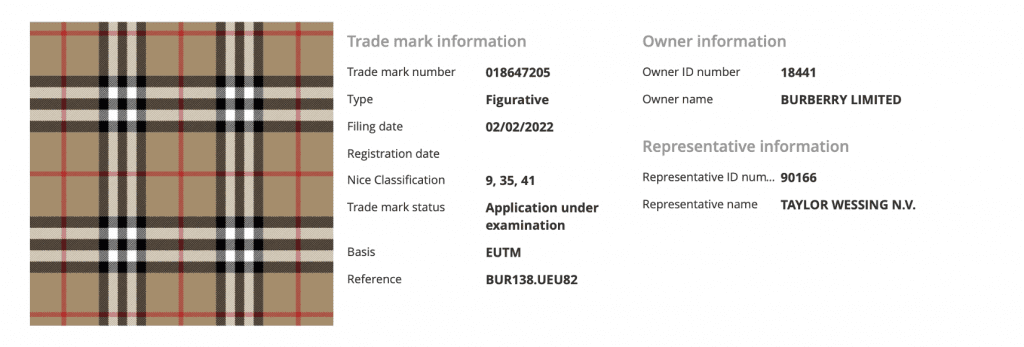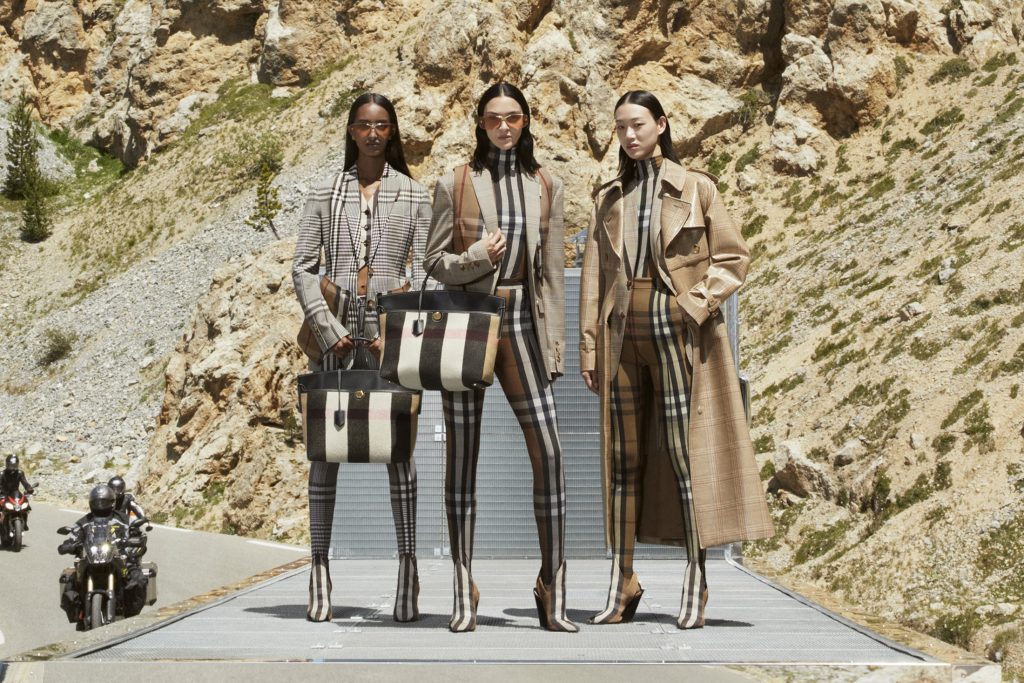The European Union Trademark Office (“EUIPO”) has refused to green-light part of a metaverse-focused trademark application that was lodged by Burberry. The partial refusal issued by the EUIPO on Wednesday stems from the trademark application for registration that Burberry filed in Feb. 2022 for its well-known “check” pattern for use on web3/metaverse-related goods/services, namely, “non-fungible tokens (‘NFTs’) or other digital tokens based on blockchain technology [and] downloadable virtual goods,” etc. (in Class 9), “online retail services related to fashion, clothing and related accessories” (in Class 35), and “providing online non-downloadable digital collectibles namely art, photographs, clothing and accessories,” etc. (in Class 41).
In the partial refusal, EUIPO examiner Päivi Emilia Leino states that the Burberry check trademark is devoid of distinctiveness under Article 7(1)(b) EUTMR – which prohibits the registration of marks that “are devoid of any distinctive character” – for certain “objected” goods and services listed in Burberry’s application. The “objected” goods/services include: (1) “NFTs and digital tokens, downloadable goods, such as downloadable digital graphics and virtual goods and other virtual material” in Class 9; (2) “Retail and wholesale services of goods and presentation of goods on communication media for retail purposes” in Class 35; and (3) “Services that provide online non-downloadable digital collectibles, online information and entertainment” in Class 41.

According to Leino, the EUIPO “states that a combination of elements forming a check pattern is obvious and typical for the goods and not essentially different from other check patterns commonly found in the trade.” In particular, the EUIPO examiner notes that the pattern depicted in the Burberry is “not markedly different from various basic patterns commonly used in the trade for the goods and services for which an objection has been raised,” and points to examples of allegedly similar uses of the pattern on apparel and/or accessories by brands like Anine Bing, Mango, and Boohoo, among others.
More generally, the examiner maintains that “a mark consisting of a decorative pattern that is simple and commonplace is considered devoid of any element that could attract the consumers’ attention, and insufficient to indicate the source or origin of goods or services.”
The fact that Burberry’s check pattern is “commonly used” for “real world” goods – as distinct from virtual ones – is not significant, per Leino, who contends that the EUIPO “notes that the consumer’s perceptions for real-world goods can be applied to equivalent virtual goods as a key aspect of virtual goods is to emulate core concepts of real-world goods.”
A read between the lines here seems to suggest that trademark applications for registration for virtual goods may essentially be examined in the same manner as applications for those marks for use in connection with their “real world” equivalents. In Burberry’s case, that means carrying over any potential lack of distinctiveness into the virtual world. (It is worth noting that the Burberry “check” mark was previously registered by the EUIPO for use on leather goods, textiles, and apparel, as well as eyewear, retail services, etc. in a separate application.) With that in mind, it is not difficult to imagine the EUIPO pushing back against virtual uses of Louis Vuitton’s Damier checkered pattern, Dior’s saddle bag, Tecnica’s moon boots, and other marks that have faced Article 7(1)(b)-specific pushback.
While the EUIPO determined that Burberry’s check mark is devoid of distinctive character for use on the “objected” goods/services, namely, virtual apparel and accessories, this round was not a total loss for Burberry. The EUIPO has allowed the application to proceed for certain goods/services in Class 9, namely, “Downloadable interactive characters, avatars and skins; Video games and downloadable video game software,” and Class 41, including “Providing on-line information about digital games; Providing online video games; Provision of online information in the field of computer games entertainment; Entertainment services, namely, providing online electronic games, providing a website with non-downloadable computer games and video games.” It is unclear why – and is “slightly inconsistent,” according to HGF attorney Lee Curtis – that the EUIPO has rejected registration of the mark for use on virtual goods but not for downloadable skins.
The EUIPO’s refusal – which Burberry can now appeal – comes as no shortage of brands have sought to register their existing trademarks for use in connection with metaverse/web3 goods/services. It also follows from the EUIPO issuing metaverse/NFT-specific guidance this past fall as to the approach that it is taking for classification purposes for marks filed in this realm, and setting out official figures, noting that it has been “registering applications using NFTs and the metaverse” since 2021.











